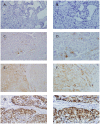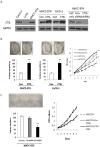Increased expression of cathepsin L: a novel independent prognostic marker of worse outcome in hepatocellular carcinoma patients
- PMID: 25384089
- PMCID: PMC4226473
- DOI: 10.1371/journal.pone.0112136
Increased expression of cathepsin L: a novel independent prognostic marker of worse outcome in hepatocellular carcinoma patients
Abstract
Objectives: To investigate the expression and role of Cathepsin L (CTSL) in Hepatocellular carcinoma (HCC) tissue and cell line (MHCC-97H), and to evaluate the clinical and prognostic significance of CTSL protein in patients with HCC.
Methods: The expression of CTSL was examined in HCC tissue and MHCC-97H cells by Western-blotting, Real-time PCR and immunohistochemical staining. Cell growth curve assay and colony formation assay were used to verify the effect of CTSL on the proliferation and tumor progression ability of MHCC-97H cells. Tumor formation assay in nude mice was used to analyze the effect of CTSL on the tumorigenicity of MHCC-97H cells.
Results: The status of CTSL protein in carcinoma tissues is much higher than that in paracarcinoma tissues. The overall survival of the patients with high CTSL expression was significantly shorter than the low CTSL expression group. high CTSL expression was significantly correlated with advanced clinical staging, histological grade and tumor recurrence. In vitro experiments demonstrated that over-expression of CTSL in MHCC-97H cells promoted cell proliferation and tumor progression ability. Down-regulation of CTSL showed the opposite effects. Over-expression of CTSL increase the tumorigenicity of MHCC-97H cells by in vivo experiments. Moreover, multivariate analysis suggested that CTSL expression might be an independent prognostic indicator for the survival of HCC patients after curative surgery.
Conclusions: CTSL might involve in the development and progression of HCC as a oncogene, and thereby may be a valuable prognostic marker for HCC patients.
Conflict of interest statement
Figures





References
-
- Capocaccia R, Sant M, Berrino F, Simonetti A, Santi V, et al. (2007) Hepatocellular carcinoma: trends of incidence and survival in Europe and the United States at the end of the 20th century. Am J Gastroenterol 102: 1661–1670, 1660, 1671. - PubMed
-
- Kane SE, Gottesman MM (1990) The role of cathepsin L in malignant transformation. Semin Cancer Biol 1: 127–136. - PubMed
Publication types
MeSH terms
Substances
LinkOut - more resources
Full Text Sources
Other Literature Sources
Medical

